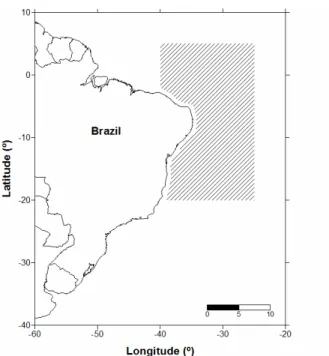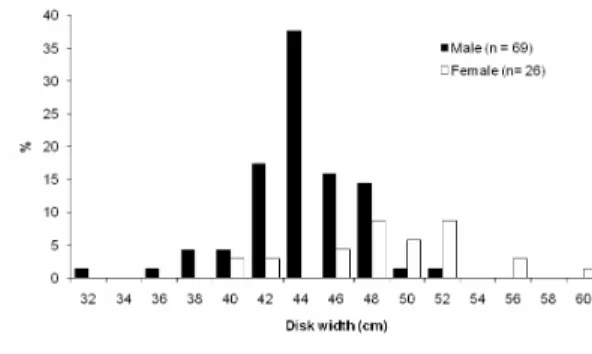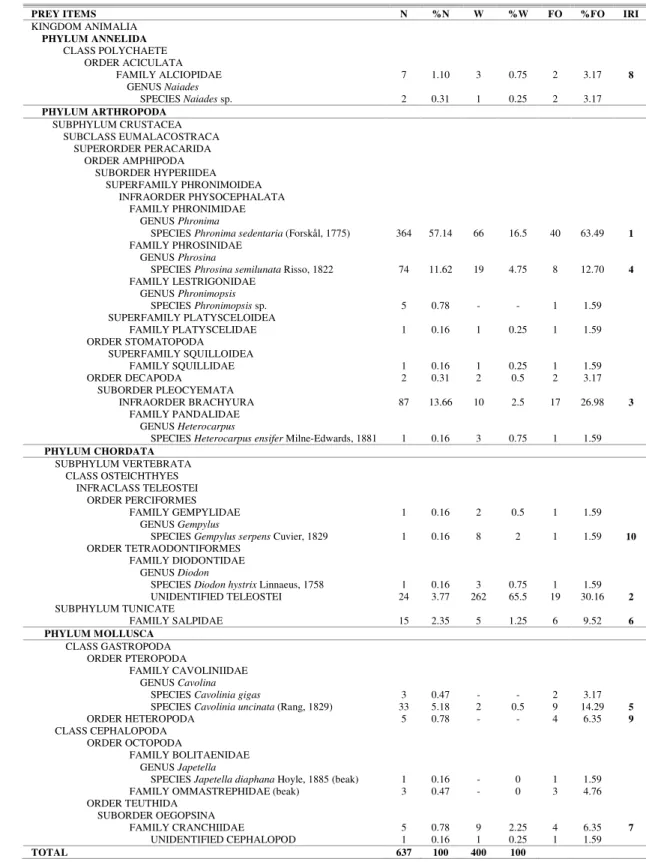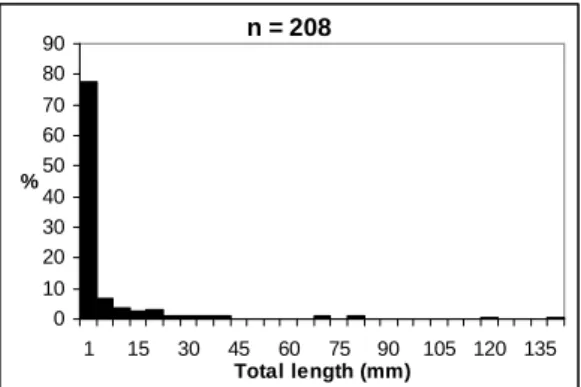STOMACH CONTENTS OF THE PELAGIC STINGRAY (
Pteroplatytrygon violacea
)
(ELASMOBRANCHII: DASYATIDAE) FROM THE TROPICAL ATLANTIC
Dráusio Pinheiro Véras1,3, Teodoro Vaske Júnior2, Fábio Hissa Vieira Hazin3, Rosangela Paula Lessa2, Paulo Eurico Travassos4, Mariana Travassos Tolotti1,4 and Taciana Martins Barbosa2
1Universidade Federal de Pernambuco – Departamento de Oceanografia (Cidade Universitária, 50670-901 Recife, PE, Brasil)
E-mail: drausioveras@bol.com.br
2Universidade Federal Rural de Pernambuco - DIMAR/DEPAQ (Av. Dom Manuel de Medeiros s/n, Dois Irmãos, 52171-900 Recife, PE, Brasil) E-mail: vaske@ig.com.br; rlessa@depaq.ufrpe.br; taciana.martins@hotmail.com
3Universidade Federal Rural de Pernambuco - LOP/DEPAq
(Av. Dom Manuel de Medeiros s/n, Dois Irmãos, 52171-900 Recife, PE, Brasil) E-mail: fhvhazin@terra.com.br
4Universidade Federal Rural de Pernambuco - LEMAR/DEPAq (Av. Dom Manuel de Medeiros s/n, Dois Irmãos, 52171-900 Recife, PE, Brasil)
E-mail: p.travassos@depaq.ufrpe.br; mari.trrr@gmail.com
The pelagic stingray Pteroplatytrygon violacea (Bonaparte, 1832) is the only pelagic dasyatid
ray occurring in tropical and subtropical waters of the Atlantic, Indian and Pacific Oceans (BIGELOW; SCHROEDER, 1953; MOLLET, 2002; ELLIS, 2007). This poorly known species was originally described from the Mediterranean Sea, and was first reported from the Atlantic by Bigelow & Schroeder (1962). The species has no commercial value, but is fairly abundant off the Southeastern United States representing about 2.5% in number of the catches by pelagic longlines between 1992-2000 (BEERKIRSHER et al., 2004).
The first record in southern Brazilian waters was reported by Sadowski; Amorim (1977) and Mazzoleni; Schwingel (2002) subsequently recorded the pelagic stingray as a bycatch species regularly caught by tuna longliners off southern Brazil. Menni et al. (1995) reported on the presence of the pelagic stingray in northeastern Brazilian waters. Although the pelagic stingray is caught regularly by tuna longliners operating along the Brazilian coast, few biological data are available on the species. In this context, the stomach contents of the pelagic stingray were analyzed to provide more specific information on its feeding habits in the southwestern equatorial Atlantic Ocean.
The sampled area was located between 40º- 25ºW and 5ºN-20ºS (Fig. 1). All specimens were caught by the Research Vessel Riobaldo (CEPENE-IBAMA), in the years 1993, 1994 and 1995 through the Ecotuna Project, and by the Brazilian tuna longline fleet, in the years 2005 and 2006 (SEAP, Onboard
Observer Program), in waters of 2000 to 5000 m local depth, with hook depth between 50 and 250 m along the longline. The specimens were stored on ice onboard, and at the laboratory, they were sexed and had their disc width measured to the nearest centimeter.
A total of 106 specimens were analyzed (69 males, 26 females, and 11 with no sex information). Females wereslightly larger, ranging between 40.0 cm and 60.0 cm, with a mean disc width of 49.0 cm. Males varied from 32.0-50.0 cm, with a mean disc width of 43.5 cm (Fig. 2).
Fig. 2. Size distribution (disc width) for the pelagic stingray.
The stomachs were removed and preserved in 10%formalin, with the food items subsequently identified to the lowest possible taxon. The importance of each food item in the diet was obtained by the Index of Relative Importance (IRI) (PINKAS et al., 1971), utilizing weight data:
IRIi = %FOi x (%Ni x %Wi)
Where %FOi is the relative frequency of occurrence of each item; %Ni is the proportion in prey number of each item in the total food; and %Wi is the proportion in weight of each item in the total food. Longline baits (Loligo sp. and Scomber japonicus) were not included. Preys in very good condition had their total length measured to investigate preferential prey sizes ingested in the size range of the rays sampled.
Two species of fish were observed (Diodon hystrix and Gempylus serpens), although most fish
remains could not be identified. Various cephalopods were observed, including glass squid (Cranchiidae), ommastrephid squids and the octopod Japetella diaphana. Crustaceans were well represented in the
diet, especially in terms of hyperiid amphipods (Phronima sedentaria, Phronimopsis sp., Phrosina semilunata and platyscelids), with shrimps
(Heterocarpus ensifer), brachyuran megalopae, and
squillids also consumed. Other prey included tunicates, pteropods and heteropods (Table 1).
The five most important prey were included among the hyperiid amphipods, teleosts, brachyuran megalopae and pteropods. Although prey size ranged from 1.0 to 140.0 mm length, most prey were between
1.0 and 40.0 mm, being represented by small crustaceans, pteropods and heteropods (Fig. 3). The largest prey species were fish, cephalopods and polychaetes.
References in the literature describe the pelagic stingray as epipelagic (SCOTT; TIBBO, 1968; WILSON; BECKETT, 1970; SADOWSKI; AMORIM, 1977; BRANSTETTER; MCEACHRAN, 1983; PRATT et al, 1990; MENNI et al., 1995), although Nakaya (1982) suggested that they may be a benthopelagic species, utilizing both benthic and pelagic habitats, since captures of pelagic stingray were observed between 330 and 381 m depth, with occasional incursions to superficial waters. However, Bañón et al. (1997) had observed and suggested that
the P. violacea was probably caught in the top 100 m
in the bottom trawl fishery, when the bottom trawl at 800 m was hauled up. Siqueira and Sant’Anna (2007) obtained specimens from the artisanal fishery, caught by handline, operating at depths from 30 to 45 m in the adjacent areas of Father Island and Shallow Island, Rio de Janeiro. Therefore, the distribution of P. violacea in the water column is probably related to the
geographical location and environmental parameters of the region.
Table 1. Percentages in number, weight, and frequency of occurrence of food items of Pteroplatytrygon violacea in the Southwestern equatorial Atlantic. IRI – Index of Relative Importance, ranging from 1 to 10 in order of importance.
PREY ITEMS N %N W %W FO %FO IRI
KINGDOM ANIMALIA PHYLUM ANNELIDA
CLASS POLYCHAETE ORDER ACICULATA
FAMILY ALCIOPIDAE 7 1.10 3 0.75 2 3.17 8
GENUS Naiades
SPECIES Naiades sp. 2 0.31 1 0.25 2 3.17
PHYLUM ARTHROPODA SUBPHYLUM CRUSTACEA
SUBCLASS EUMALACOSTRACA SUPERORDER PERACARIDA
ORDER AMPHIPODA SUBORDER HYPERIIDEA
SUPERFAMILY PHRONIMOIDEA INFRAORDER PHYSOCEPHALATA
FAMILY PHRONIMIDAE GENUS Phronima
SPECIES Phronima sedentaria (Forskål, 1775) 364 57.14 66 16.5 40 63.49 1
FAMILY PHROSINIDAE GENUS Phrosina
SPECIES Phrosina semilunata Risso, 1822 74 11.62 19 4.75 8 12.70 4
FAMILY LESTRIGONIDAE GENUS Phronimopsis
SPECIES Phronimopsis sp. 5 0.78 - - 1 1.59
SUPERFAMILY PLATYSCELOIDEA
FAMILY PLATYSCELIDAE 1 0.16 1 0.25 1 1.59
ORDER STOMATOPODA SUPERFAMILY SQUILLOIDEA
FAMILY SQUILLIDAE 1 0.16 1 0.25 1 1.59
ORDER DECAPODA 2 0.31 2 0.5 2 3.17
SUBORDER PLEOCYEMATA
INFRAORDER BRACHYURA 87 13.66 10 2.5 17 26.98 3
FAMILY PANDALIDAE GENUS Heterocarpus
SPECIES Heterocarpus ensifer Milne-Edwards, 1881 1 0.16 3 0.75 1 1.59
PHYLUM CHORDATA SUBPHYLUM VERTEBRATA
CLASS OSTEICHTHYES INFRACLASS TELEOSTEI
ORDER PERCIFORMES
FAMILY GEMPYLIDAE 1 0.16 2 0.5 1 1.59
GENUS Gempylus
SPECIES Gempylus serpens Cuvier, 1829 1 0.16 8 2 1 1.59 10
ORDER TETRAODONTIFORMES FAMILY DIODONTIDAE
GENUS Diodon
SPECIES Diodon hystrix Linnaeus, 1758 1 0.16 3 0.75 1 1.59
UNIDENTIFIED TELEOSTEI 24 3.77 262 65.5 19 30.16 2
SUBPHYLUM TUNICATE
FAMILY SALPIDAE 15 2.35 5 1.25 6 9.52 6
PHYLUM MOLLUSCA CLASS GASTROPODA
ORDER PTEROPODA
FAMILY CAVOLINIIDAE GENUS Cavolina
SPECIES Cavolinia gigas 3 0.47 - - 2 3.17
SPECIES Cavolinia uncinata (Rang, 1829) 33 5.18 2 0.5 9 14.29 5
ORDER HETEROPODA 5 0.78 - - 4 6.35 9
CLASS CEPHALOPODA ORDER OCTOPODA
FAMILY BOLITAENIDAE GENUS Japetella
SPECIES Japetella diaphana Hoyle, 1885 (beak) 1 0.16 - 0 1 1.59
FAMILY OMMASTREPHIDAE (beak) 3 0.47 - 0 3 4.76
ORDER TEUTHIDA SUBORDER OEGOPSINA
FAMILY CRANCHIIDAE 5 0.78 9 2.25 4 6.35 7
UNIDENTIFIED CEPHALOPOD 1 0.16 1 0.25 1 1.59
n = 208
0 10 20 30 40 50 60 70 80 90
1 15 30 45 60 75 90 105 120 135
Total length (mm) %
Fig. 3. Prey size distribution of the pelagic stingray.
The pelagic stingray is an epipelagic predator that in the southwestern equatorial Atlantic feeds mainly upon small crustaceans, especially hyperiid amphipods, brachyuran megalopae, and also pteropods, fish and cephalopods. The pelagic feeding habits are further confirmed by the presence of pelagic stingrays in drift gill-net fisheries off southern California (HANAN et al., 1993) and in the Gulf of California (DÁVALOS-DEHULLU; GONZÁLEZ-NAVARRO, 2003).
The stingray catches the bait by wrapping their wings around it and nibbling it until it is gone or until they are hooked (MOLLET, 2002). Bigelow and Schroeder (1962) found two seahorses Hippocampus
sp., two small shrimps, and fragments of squid in one specimen. SCOTT; TIBBO (1968), found parts of a thalassinoid decapod in a specimen from the northwestern Atlantic, and Wilson and Beckett (1970) found sargassum weed, squid beaks, seahorses, unidentified fish and coelenterates in 16 specimens from the North Atlantic. Two semi-digested skulls of
Scomber japonicus with a standard length of 235 mm
were found in the stomach of a female P. violacea in the Gulf of California (DÁVALOS-DEHULLU; GONZÁLEZ-NAVARRO, 2003), although the authors did not comment on the possibility of these S. japonicus originating from longline bait.
Ribeiro-Prado and Amorim (2008) found mollusca as the most common group, noting also Actinopterygii fishes and Crustaceans in stomachs of P. violacea. Siqueira and Sant’Anna (2007) observed only unidentified teleost remains (vertebrae fragments and crystallines).
The dorsal and ventral dark violet color may help to camouflage the pelagic stingrays while they seek pelagic prey in the water column. Besides, the teeth of the pelagic stingray differs from those of most other rays of the Dasyatidae by the presence of cuspidate cutting teeth in both male and female jaws, which contrast with the crushing dentitions of their demersal relatives. These cutting teeth are probably
more efficient for grasping small crustaceans. Differences found in the dentition and the swimming behavior of this species, in relation to other Dasyatis
spp., appear to be autapomorphic (character state that is unique to a particular species or lineage in the group under consideration) functional adaptations to a pelagic lifestyle and a diet of fish and squid (ROSENBERGER, 2001), although prey preferences may vary, as observed in this study, where small crustaceans were more important than fish and squid.
The data and comments above suggest that the P. violacea alter their food items according to their
geographical location and also shows how the species, despite belonging to the Dasyatidae family, is adapted to the pelagic environment.
A
CKNOWLEDGEMENTSThe authors are grateful to the CEPENE-IBAMA, to the Department of Fisheries and Aquaculture of the Federal Rural University of Pernambuco, Brazil, where the stomachs were examined. The present study was also made possible by funding from the Special Secretariat for Aquaculture and Fisheries of the Presidency of the Republic of Brazil (SEAP) and the Brazilian Onboard Observer Program, also of SEAP.
REFERENCES
BAÑÓN, R.; CASAS, J. M.; PINEIRO, C. G.; COVELO, Y. M. Capturas de peces de afinidades tropicales en aguas Atlánticas de Galicia (noroeste de la península Ibérica). Boln Inst. esp. Oceanogr., v. 13, p. 57–66. 1997. BEERKIRCHER, L. R.; CORTES, E.; SHIVJI, M.
Characteristics of shark bycatch observed on pelagic longlines off the southeastern United States, 1992-2000. Mar. Fish. Rev., v. 64, n. 4, p. 40-49, 2004.
BIGELOW, H. B.; SCHROEDER, W. C. Sawfishes, guitarfishes, skates and rays. In: TEE-VAN, J. et al. (Ed). Fishes of the Western North Atlantic , Part 2. New Haven: Mem. Sears Fnd . mar. Res.., Yale Univ., 1953. p. 1-514.
BIGELOW, H. B.; SCHROEDER, W. C. New and little known batoid fishes from the western Atlantic. Bull. Mus. comp. Zool. Harv., v. 128, n. 4. p. 161-244, 1962.
BRANSTETTER, S.; MCEACHRAN, J. C. A first record of the bigeye thresher, Alopias superciliosus, the blue
shark, Prionace glauca, and the pelagic stingray,
Dasyatis violacea, from the Gulf of Mexico. NE Gulf Sci., v. 6, p. 59-61, 1983.
DÁVALOS-DEHULLU, E.; GONZÁLEZ-NAVARRO, E. Stomach content of one pelagic ray Dasyatis violacea
ELLIS, J. R. Occurrence of pelagic stingray Pteroplatytrygon violacea Bonaparte, 1832) in the North Sea. J. Fish Biol., v. 71, p. 933–937, 2007.
FORSELLEDO, R.; PONS, M.; MILLER, P.; DOMINGO, A. Distribution and population structure of the pelagic stingray, Pteroplatytrygon violacea (Dasyatidae), in the
south-western Atlantic. Aquat. Living Resour., v. 21, n. 4, p. 357-363. 2008.
HANAN, D. A.; HOLTS, D. B.; COAN, A. L. JR. The California drift gill net fishery for shark and swordfish 1980–81 through 530 H. F. Mollet http://www.publish.csiro.au/ journals/mfr 1990–91. Fish
Bull. Calif. Fish Game, v.175, p. 1–93, 1993.
MAZZOLENI, R. C.; SCHWINGEL, P. R. Aspectos da biologia das espécies capturadas por espinhel pelágico na região sul das ilhas de Trindade e Martin Vaz no verão de 2001. Notas téc. FACIMAR, v. 6, p. 51-57, 2002. MENNI, R. C.; LÓPEZ, H. L.; GOSZTONYI, A. E. Sobre la
ecología y biología de Halaelurus bivius
(Chondrichthyes, Scyliorhinidae). Revta Mus. argent. Cienc.nat. Bernardino Rivadavia Inst. nac. Invest. Cienc. nat., (Ecol.), v. 2, n. 3, p. 71-88, 1979.
MENNI, R.C.; HAZIN, F. H.; LESSA, R. P. T. Occurrence of the night shark Carcharhinus signatus and the pelagic stingray Dasyatis violacea off northeastern Brazil.
Neotropica, v. 41, n. 1056-106, p. 105-110, 1995. MOLLET, H. F. Distribution of the pelagic stingray,
Dasyatis violacea Bonaparte, 1832), off California, Central America, and worldwide. Bull. mar. Freshwater Res, v. 53, p. 525–530, 2002.
MOLLET, H. F.; EZCURRA J. M.; O’SULLIVAN J. B. Captive biology of the pelagic stingray, Dasyatis violacea (Bonaparte, 1832) Bull. mar. Freshwater Res., v. 53, p. 531–541, 2002.
NAKAYA, K. Dasyatis violacea. In: OKAMURA, O. et al.
(Ed.). Fishes of the Kyushu-Palau Ridge and Tosa Bay. Tokyo: JAMARC, Tosho Printing Co., 1982. p. 54-55, 315.
ODDONE, M. C.; PAESCH, L.; NORBIS, W.; VALESCO, G. Population structure, distribution and abundance patterns of the patagonian smoothhound Mustelus schmitti Springer, 1939 (Chondrichthyes, Elasmobranchii, Triakidae) in the rio de La Plata and inner continental shelf, sw Atlantic ocean (34º30'-39º30'S). Braz. J. Oceanogr., v. 55, n. 3, p. 167-177, 2007.
PINKAS, L.; OLIPHANT, M. S.; IVERSON, I. L. K. Food habits of albacore, bluefin tuna, and bonito in Californian waters. Calif. Dep. Fish Game, Fish. Bull., v. 152, 105 p, 1971.
PRATT, H. L. JR.; S. H. GRUBER; T. TANIUCHI, T. (Ed.). Elasmobranchs as living resources: advances in the biology, ecology, systematics, and the status of the fisheries. U.S. Dep. Commer., NOAA tech. Rep., NMFS, n. 90, 519 p, 1990.
RIBEIRO-PRADO, C. C. ; AMORIM, A. F. Fishery biology on pelagic stingray Pteroplatytrygon violacea caught off
southern Brazil by longliners settled in São Paulo State (2006-07). International Commission for the Conservation of Atlantic Tunas, v. 62, n.6, p. 1883-1891, 2008. Collective Volume of Scientific Papers.
ROSENBERGER, L. J. Phylogenetic Relationships within the Stingray Genus Dasyatis (Chondrichthyes:
Dasyatidae) Copeia, v. 2001, n. 3, p. 615–627, 2001. SADOWSKI, V.; AMORIM, A. F. Primeiro registro de
ocorrência da arraia pelágica Dasyatis violacea
(Bonnaparte, 1832) nas águas do Atlântico sul ocidental. Ciênc. Cult., São Paulo, v. 29, n. 7, p. 792, 1977. SCOTT, W. B.; TIBBO, S. N. An occurrence of the pelagic
stingray, Dasyatis violacea, in the Northwest Atlantic. J. Fish. Res. Bd. Canada, v. 25, p. 1075-1076, 1968. SIMS, D. W., NASH, J. P.; MORRITT, D. Movements and
activity of male and female dogfish in a tidal sea lough: alternative behavioural strategies and apparent sexual segregation. Mar. Biol., v. 139, p. 1165–1175. 2001. SIQUEIRA, A. E. ; SANT´ANNA, V. B. Data on the Pelagic
Stingray, Pterolatytrygon violacea (Bonaparte, 1823)
(Myliobatiformes: Dasyatidae) caught in the Rio de Janeiro coast. Braz. J. Oceanogr., v. 55, p. 323-325, 2007. SPRINGER, S. Social organization of shark populations. In:
GILBERT, P. W.; MATHEWSON, R. F.; RALL, D. P. (Ed.). Sharks, Skates and Rays. Baltimore, MD: John Hopkins Press, 1967. p. 149-174.
WILSON, P. C.; BECKETT, J. S. Atlantic ocean distribution of the pelagic stingray, Dasyatis violacea. Copeia, v. 4, p. 696-707, 1970.



